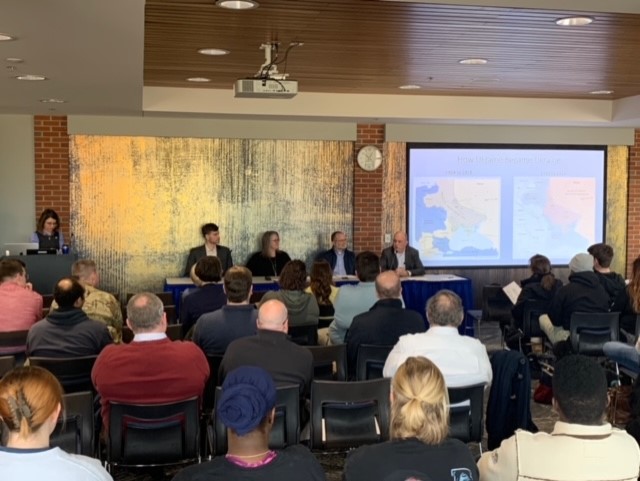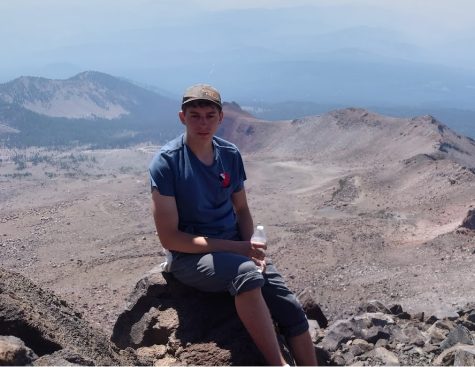SDSU experts host Ukraine discussion panel
SDSU faculty members Filip Viskupic, Lynn Sargeant, Chuck Vollan and Will Prigge discuss the Ukrainian invasion at a roundtable panel.
March 29, 2022
South Dakota State University hosted a discussion panel Tuesday featuring faculty with insight regarding the Russian Federation’s invasion of Ukraine. The panel, moderated by Evren Celik Wiltse, an associate professor of political science, featured four experts: Lynn Sargeant, Will Prigge, Chuck Vollan and Filip Viskupic.
Lynn Sargeant:
Sargeant, who serves as the Dean of the College of Arts, Humanities and Social Sciences at SDSU, earned her Ph.D. and M.A. in Russian history. She also has spent time in both Russia and Ukraine, living in Kharkiv and Kyiv in Ukraine, and numerous cities in Russia including St. Petersburg and Moscow.
Sargeant addressed Russian President Vladimir Putin’s claim that Ukraine isn’t its own nation, and that the Russian and Ukrainian people are one.
“[Putin] made assertions that Ukraine is an invention of the Bolsheviks, (Vladimir) Lenin and the autonomy within the Soviet Union … was a mistake,” Sargeant said.
Sargeant overviewed some of the shared ties between the nations, explaining that Russia and Ukraine share a complex historical and political origins going as far back as the ninth century. The Kievan Rus, according to Sargeant, was a precursor to the modern states of both Russia and Ukraine, with the city of Kyiv at the center. Other differences include religion, as Ukrainian orthodox and Russian Orthodox are separate entities and often conflict.
“[Putin is also] pointing to this idea that Ukrainian is not a real language; that it’s an offshoot or bastardization or small variant of Russian,” Sargeant said. “But actually, Russian, Ukrainian, Belarusian and Polish are all very closely related Slavic languages.”
Sargeant wrapped up her monologue with the reading of a Ukrainian poem, first in its original Ukrainian and then in English. (See bottom of page).
“I don’t think anyone has done more to cement Ukraine’s national identity than Vladimir Putin,” Sargeant said.
Prigge:
Prigge, a professor of history at SDSU, specializes in the history of Soviet Republics during the 1950s and 1960s. He has lived in cities including Riga, Latvia, as well as Kyiv and Moscow. He also spent a semester in Moldova as a Fullbright fellow and is the author of “Bearslayers: The Rise and Fall of the Latvian National Communists.”
Prigge connected current events to events in the 20th century.
“I’ve been thinking about how we should see things in a big arc of history, and they’re not exact replicas,” Prigge said. “But things are reminiscent of earlier events.”
Prigge pointed out four landmark years: 1919 with the Paris Peace Conferences, 1938/39 with Hitler’s invasion, 1991 with the collapse of the U.S.S.R., and now 2022 with the Russian invasion.
When the treaty of Versailles was created, it was when some countries, specifically Germany, were in weak positions. Germany viewed the treaty as a bad deal, and years later, with a repaired economy and thus stronger position, sought to change the terms.
Prigge made an allusion between Versailles and the collapse of the U.S.S.R., when Russia was in a weak position and couldn’t act in its own self interest. He suggested Putin believes the west took advantage of Russia’s weakness. Now that Russia is in a stronger position, Prigge said Putin may feel better poised.
Prigge also spoke about national self-determination, or the idea that every nation is entitled to its own state.
“If you live in a multinational empire … you’re liable to be subjected to the whims and prejudices of the majority,” Prigge said. “The best example of the problem of an ethnic minority living under a majority would be the Jews in the Holocaust and thus the need for the Jewish nation state after the second world war.”
Prigge highlighted the challenges of creating nations that encompass an ethnic group of people, as clusters of different groups are often scattered across huge swaths of land.
“Even if you wanted to draw state boundaries, you’d just have nothing but pockets of groups spread throughout. It doesn’t lend itself to a continuous border,” Prigge said.
Vollan:
Vollan, an associate professor of history at SDSU, focuses on American history in the 19th and 20th centuries and has Ukrainian and Polish heritage.
According to Vollan, about 0.31% of Amercians, or a little over one million people, claim Ukrainian heritage in the United States.
Ukrainian immigrants in the earlier 20th century were people who worked with their hands. Many were farmers, miners and factory workers who wanted to come to the U.S. to make good money, and then return to Ukraine. A second wave of immigration followed World War I.
In 1929, Ukrainian farms were collectivized. The Soviets took the food the Ukrainians grew, refused to allow Ukrainians to leave and would not allow outside aid. The Holodomor, which roughly translates to “death by hunger,” claimed the lives of between three and seven million (estimated) Ukrainians.
Dr. Viskupic:
Viskupic is an assistant professor of political science at SDSU. He teaches courses on U.S. foreign policy, international relations and current world issues. He was also born and raised in Slovakia, which borders part of Ukraine’s western edge.
Putin is fed filtered information and lives in a state of isolation, Viskupic said. He doesn’t use the internet, according to reports, and as a result of his notoriously small circle of advisors, functions in an echo chamber.
“The goal of Russia was to overwhelm Ukraine very quickly. In a few days, they were to capture Kyiv and install a puppet government,” Viskupic said. “It exposed the weakness of the Russian army that on paper is a really strong army. We see it performing quite poorly.”
He cautioned the audience not to believe outright the Russian casualty numbers given by the Ukrainian government, as they are likely inflated.
“The allies are only providing defensive weapons to Ukraine, perhaps in the hope that the Ukrainians will push the Russians out slowly,” Viskupic said. “If the U.S. and western allies provided offensive weapons to Ukraine, they might push the Russians out too quickly, which could push Putin into a corner and increase the chance of using weapons of mass destruction or nuclear weapons in Ukraine or perhaps Poland.”
Viskupic said the Russian government has seemingly begun to refocus its goals from demilitarization and “de-nazifcation” of Ukraine toward eastern Ukraine, perhaps as a result of intense sanctions and the realization that a military victory isn’t feasible.
The panel agreed that while Russia may be able to eke out a military victory, a win would be extremely costly to them economically and militarily—and would likely end in retreat anyway, as the Russian military may be unable to hold the land and combat the uprising.
Taras Shcevchenko, Zapovit/ Testament (1845)
When I am dead, then bury me,
In my beloved Ukraine,
My tomb upon a grave mound high
Amid the spreading plain,
So that the fields, the boundless steppes,
The Dnieper’s plunging shore
My eyes could see, my ears could hear
The mighty river roar.
When from Ukraine the Dnieper bears
Into the deep blue sea
The blood of foes… then will I leave
These hills and fertile fields –
I’ll leave them all and fly away
To the abode of God,
And then I’ll pray … But till that day
I nothing know of God.
Oh bury me, then rise ye up
And break your heavy chains
And water with the tyrants’ blood
The freedom you have gained.
And in the great new family,
The family of the free,
With softly spoken, kindly word
Remember also me.
Translated by John Weir

























